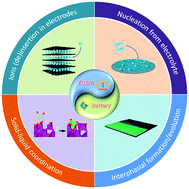From bulk to interface: electrochemical phenomena and mechanism studies in batteries via electrochemical quartz crystal microbalance
Abstract
Understanding the bulk and interfacial behaviors during the operation of batteries (e.g., Li-ion, Na-ion, Li–O2 batteries, etc.) is of great significance for the continuing improvement of the performance. Electrochemical quartz crystal microbalance (EQCM) is a powerful tool to this end, as it enables in situ investigation into various phenomena, including ion insertion/deinsertion within electrodes, solid nucleation from the electrolyte, interphasial formation/evolution and solid–liquid coordination. As such, EQCM analysis helps to decipher the underlying mechanisms both in the bulk and at the interface. This tutorial review will present the recent progress in mechanistic studies of batteries achieved by the EQCM technology. The fundamentals and unique capability of EQCM are first discussed and compared with other techniques, and then the combination of EQCM with other in situ techniques is also covered. In addition, the recent studies utilizing EQCM technologies in revealing phenomena and mechanisms of various batteries are reviewed. Perspectives regarding the future application of EQCM in battery studies are given at the end.



 Please wait while we load your content...
Please wait while we load your content...